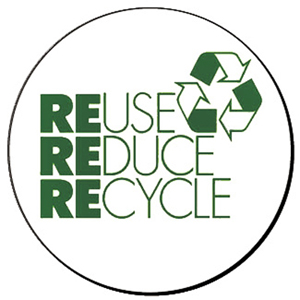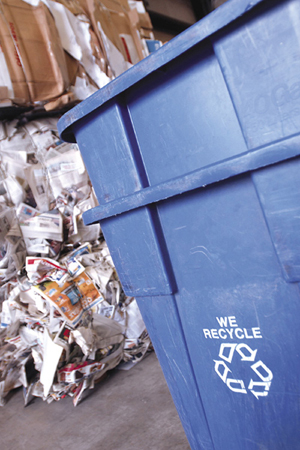Guide G-314
Fahzy Abdul-Rahman
College of Agricultural, Consumer and Environmental Sciences, New Mexico State University
Author: Extension Family Resource Management Specialist, Department of Extension Family and Consumer Sciences, New Mexico State University. (Print friendly PDF)
Introduction
This publication provides an overview of the reasons and ways to better manage garbage or other household waste. While "recycle" may be a buzzword for an environmentally friendly way to manage waste, a more comprehensive approach to doing so is summarized by the "Three Rs":

I. Reduce: Buy only what you need because a better way to reduce waste is by not creating it.
II. Reuse: If you have to acquire goods, try getting used ones or obtaining substitutes.
III. Recycle: When discarding your waste, find ways to recycle it instead of letting it go to landfill.
As a nation, we are generating more garbage and we don't know what to do with it. Ineffctive or irresponsible disposal of this waste can pollute the environment and pose a public health risk. We are running out of space in existing landfills. Citizens are discovering that there is no easy way to get rid of the garbage they once assumed could be buried or burned and forgotten.
Current disposal methods threaten our health, safety, and environment, and pose additional indirect costs to society. Most industrial, commercial, and household waste is now being placed in landfills or surface impoundments. Waste treated in this manner may contaminate groundwater, rivers, and streams. When waste is burned, it releases hazardous gases into the air and leaves toxic residues in the form of ash. These hazardous waste byproducts find their way into humans and animals in one form or another.

The U.S. is currently recycling only a small percentage of its waste. The benefits of recycling come not only from selling recycled materials and conserving resources but also from reducing expenses or from "avoided costs."
In New Mexico, the legislature passed the Solid Waste Act of 1990, which set a goal of diverting 25% of New Mexico's municipal solid waste from landfills by 1995 and 50% by July 1, 2000. In order to manage waste, the Environmental Protection Agency (EPA) and the Solid Waste Act favor an integrated solid waste management strategy that includes 1) reducing the amount of solid waste generated, 2) recycling as much refuse as possible, 3) transforming waste in an environmentally safe manner, and 4) continuing safe landfilling. The strategies can be further discussed in the "Three Rs" approach—reduce, reuse, recycle—as briefly mentioned in the introduction.
I. Reduce
Reducing the amount you buy is the most significant of all the options to manage waste. The key is to only purchase goods that we need and in the right amount. If we never generate products in the first place, we do not have to extract raw resources, manufacture goods from scratch, come up with shipping materials, utilize additional resources for shipping, and then devise ways to dispose of them. Table 1 lays out how long it takes to decompose typical waste products.
Reducing the amount you buy can help reduce waste in surprising ways:
- Phone books: When was the last time you used a phone book? The white pages alone cost 5 million trees a year. They generated 650,000 tons of waste in 2009 (EPA, 2010). You can opt out of phone book delivery by registering your address at sites like www.yellowpagesoptout.com.
- Disposable razors: More than 2 billion disposable razors are disposed of each year in the U.S. alone (EPA, n.d.).
- Disposable diapers: In 2010, 50,000 tons of wood pulp were used to produce disposable diapers, and almost 4 million diapers were discarded in landfills (EPA, 2011). As listed in Table 1, it takes 450 years to decompose a disposable diaper.
- Cell phones: Despite great strides in manufacturing, a typical new cellphone consists of 40% metals and 40% plastics, which use oil for their manufacturing, as well as other resources for packaging and transportation. EPA estimates that more than 125 million cell phones are discarded each year, generating more than 65,000 tons of waste (EPA, 2004). Because cell phones contain hazardous materials, you should always trade in, donate, or recycle your old phones.
- Light bulbs: ENERGY STAR compact florescent light bulbs save about $6 per year and about $40 over their lifetimes (ENERGY STAR, n.d.).
Reduce: What Can We Do?
Each person adds to the waste management problem. If each household reduces its waste, the problem will be reduced. You can start by analyzing what you throw away and what goods are needed at home. Among the main steps consumers can take to reduce waste are:
Table 1. How Long Does It Take to Decompose (EPA, 2013a)
| Paper towel | 2–4 weeks | Plastic bag | 10–20 years |
| Newspaper | 6 weeks | Plastic film container | 20–30 years |
| Apple core | 2 months | Tin can | 50 years |
| Waxed milk carton | 3 months | Rubber boot sole | 50–80 years |
| Plywood | 1–3 years | Styrofoam plastic cup | 50 years |
| Wool sock | 1–5 years | Aluminum can | 80–200 years |
| Cigarette butt | 1–5 years | Plastic beverage bottle | 450 years |
| Monofilament fishing line | 600 years | ||
| Glass bottle | 1 million years | ||
- Choosing items that you need, not want: People who keep upgrading their electronics (e.g., cellphones) to the latest design are very likely to waste their money and also unnecessarily waste natural resources.
- Shopping for high-quality items: You may have to pay more, but high-quality items may last longer, perform better, and give fewer problems than lower-quality items. Instead of disposable items, opt for durable ones such as silverware, reusable cups, and reusable water bottles.
- Using minimum packaging: Packaging materials like plastic bags, boxes, packing peanuts, and plastic wrappers often wind up in landfills. Bring your own shopping bags instead of using plastic bags. If you don't have shopping bags, use paper bags instead of plastic because they decompose faster. Many stores have reusable bags for sale at the register, and some stores even have used plastic bags for consumers to use.
- Buying local products: Besides stimulating the local economy, buying local products means we can reduce negative environmental impacts from transportation.
You may be able to make some of these items at home, such as shopping bags and homemade cleaning supplies. A selection of home cleaning products and their uses are laid out in NMSU's Cooperative Extension Service Guide G-304, Selection and Use of Home Cleaning Products (http://pubs.nmsu.edu/_g/G304.pdf).
II. Reuse
The idea of being wasteful makes many people uncomfortable. Yet most of us continue to waste because we can't think of anything better to do with last year's phone book, draperies that are too short, or a closet door that was scratched by a favorite pet. We are conditioned to think of things that are old, empty, worn, broken, ugly, or marred as useless, so we throw them away without much thought about the consequences. Most Americans buy far more than they can use effectively, as evidenced by bulging attics and garages.
The process of reusing starts with the assumption that the used materials that flow through our lives can be a resource rather than refuse. Waste, after all, is in the eye of the beholder. One person's trash is another person's treasure. If we really look at things we are throwing away, we can learn to see them as materials that can be reused to solve everyday problems and satisfy everyday needs. Most of us, however, haven't even begun to exploit the resources in our trash. Once you have made up your mind to use trash for positive uses, you can begin to brainstorm and generate ideas. Reusing saves money, conserves resources, and satisfies the human urge to be creative.
Reuse: What Can We Do?
The following are some examples of reuse.
- Containers can be reused at home or for school projects.
- Reuse wrapping paper, plastic bags, boxes, and lumber.
- Give outgrown clothing to friends or charity.
- Buy beverages in returnable containers.
- Donate broken appliances to charity or a local vocational school, which can use them for art classes or for students to practice repairing.
- Offer furniture and household items that are no longer needed to people in need, friends, or charity.
- Sheets of paper that have been used on only one side can be used for note-taking or rough drafts.
- Old, outdated furniture can be reupholstered or slipcovered. Have padding added to the furniture to give it a new look. Often the frame can be modified slightly to change the way it looks.
- Old towels and sheets can be cut in small pieces and used for dust cloths.
- Books and magazines can be donated to schools, public libraries, or nursing homes.
- Newspapers can be donated to pet stores.
- Packing materials, such as polystyrene, plastic quilting, and similar materials, can be saved and reused again for packing.
- Carry a reusable tote bag or take bags to the store when you go shopping. There are attractive nylon mesh bags available that can be stored easily in the glove compartment of your car. Durable canvas bags, which take very little space to tuck away when not in use, can also be used.
- If you buy prepared microwaveable dinners, save the plates for outdoor parties or for children.
- Old tires can be used in the garden and in the play yard.
Some of the strategies are very closely related in these "Three Rs" categories. For instance, we need to reduce the use of plastic bags for grocery shopping, but we can use tote bags instead and reuse them while making sure that they are clean.
III. Recycle
The main benefits of recycling are:
- Recycling generates industry: As New Mexicans recycle, there will be a growing supply of materials generated. In order to utilize these recycled materials, manufacturing facilities will emerge to find uses for them. As more recycling plants are built and more products are manufactured, we will gain a greater understanding of the entire process.
- Recycling creates jobs: EPA estimates that recycling 10,000 tons of materials would create 36 jobs compared to six for landfilling the same amount (EPA, 2002). Some communities have formed working partnerships with workshops for the disabled, developed and administered job-training partnerships, or otherwise found work for unemployed labor in recycling programs.
- Cost avoidance of recycling: For years, recycling has been hampered by the belief that it should make money. That may be true for some recyclables, but not for others. Rather, recycling should be thought of as a cost-effective disposal option. It usually requires fewer government subsidies than landfilling or incineration. It saves natural resources and helps protect the environment. Lower taxes, energy savings, and a cleaner environment are the real "bottom lines" in favor of recycling.
Collecting Recyclables
A lot of the things that people trash can be recycled. Prime examples include paper, newspaper, corrugated cardboard, high-grade paper, aluminum, steel (tin) cans, glass, plastic, motor oil, organic waste, and scrap metals. Some notes on recycling:
- Paper with residues cannot be recycled in most cases. This is why used pizza boxes are not recyclable!
- Recycling centers will not accept light bulbs, ceramic glass, dishes, or plate glass because these items consist of different materials than bottles and jars.
- Recyclable items not accepted by your city recycling programs may be accepted by local companies. For instance, glass might not be accepted by a New Mexico city's recycling program but might be accepted by a supermarket.
- Ask your local recycling office about recycling programs and recyclable items in your area.
Main recycling collection methods are:
- Curbside collection requires homeowners to separate recyclables from their garbage. Clean recyclables may need to be placed in special containers, while the garbage goes in standard containers. Both are placed at the curb for collection by separate trucks.
- Drop-off centers are one of the simplest forms of collecting recyclable materials; people can drop off their used glass, metal, plastic, and paper at a designated recycling drop-off site. These centers are usually placed in an easily accessible location near a high-traffic area such as the entrances of supermarkets and parking lots.
- Buy back centers purchase aluminum and other metals, glass, plastic, newsprint, and sometimes batteries and other materials.
| The "Three Rs" (Reduce, Reuse, and Recycle) effort to promote better waste management needs to be done in an effective manner. If converting an old pair of jeans into a shopping bag that needs continuous repair, you are better off donating the jeans in the first place and purchasing reusable shopping bags. Some efforts may involve a steep learning curve and require time to get used to. Sorting out recyclable items may be challenging in the beginning, but once you get the hang of the system the related chores will become like effortless habits. |
References
ENERGY STAR. n.d. Light bulbs for consumers [Online]. Retrieved from https://www.energystar.gov/index.cfm?fuseaction=find_a_product. showProductGroup&pgw_code=LB
Environmental Protection Agency. n.d. Fact flash — 6: Resource Conservation and Recovery Act (RCRA) [Online]. Retrieved from
https://www.epa.gov/superfund/students/clas_act/haz-ed/ff06.pdf
Environmental Protection Agency. 2002. Campaigning against waste [EPA 530-F-02-033]. Washington, D.C.: Author.
Environmental Protection Agency. 2004. The life cycle of a cell phone [Online]. Retrieved from https://www.epa.gov/osw/education/pdfs/life-cell.pdf
Environmental Protection Agency. 2010. Municipal solid waste in the United States: 2009 facts and figures [Online]. Retrieved from
https://www.epa.gov/epawaste/nonhaz/municipal/pubs/msw2009rpt.pdf
Environmental Protection Agency. 2011. Municipal solid waste generation, recycling, and disposal in the United States: Tables and figures for 2010 [Online]. Retrieved from https://www.epa.gov/wastes/nonhaz/municipal/pubs/2010_MSW_Tables_and_Figures_508.pdf
Environmental Protection Agency. 2013a. Environmental factoids [Online]. Retrieved from https://www.epa.gov/smm/wastewise/wrr/factoid.htm
Environmental Protection Agency. 2013b. Wastes [Online]. Retrieved from https://www.epa.gov/osw/
U.S. Energy Information Administration (n.d.) Using & Saving Energy. Retrieved from https://www.eia.gov/kids/energy.cfm
Original version adapted with permission by Susan Wright from Florida Cooperative Extension Service publication HE 3157, by Marie Hammer and Jonathan Earle. Subsequent revisions by Constance Kratzer, family resource management specialist.

Fahzy Abdul-Rahman is the Extension Family Resource Management Specialist at New Mexico State University. He earned his Ph.D. and M.P.H. from The Ohio State University. His Extension programs focus on various personal finance topics, from basic banking to retirement planning.
To find more resources for your business, home, or family, visit the College of Agricultural, Consumer and Environmental Sciences on the World Wide Web at pubs.nmsu.edu
Contents of publications may be freely reproduced for educational purposes. All other rights reserved. For permission to use publications for other purposes, contact pubs@nmsu.edu or the authors listed on the publication.
New Mexico State University is an equal opportunity/affirmative action employer and educator. NMSU and the U.S. Department of Agriculture cooperating.
Revised January 2014, Las Cruces, NM


